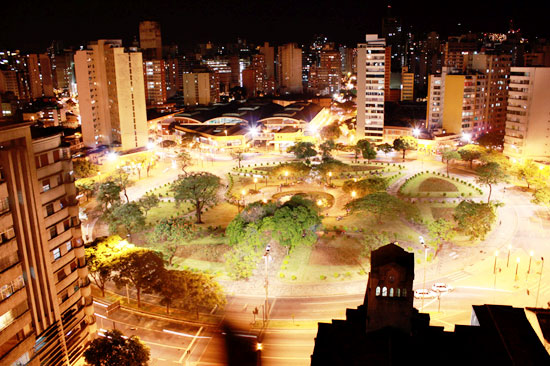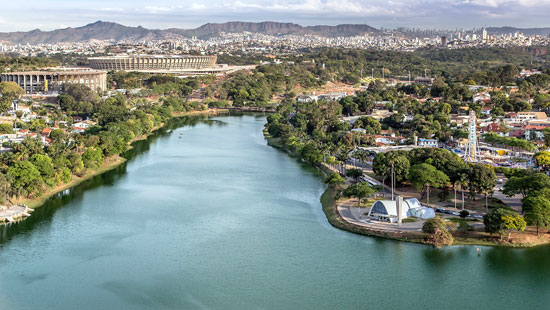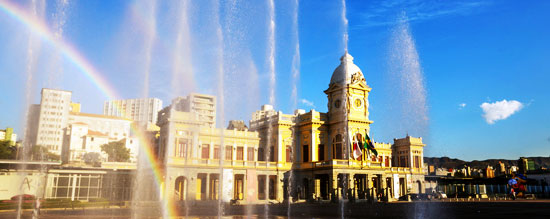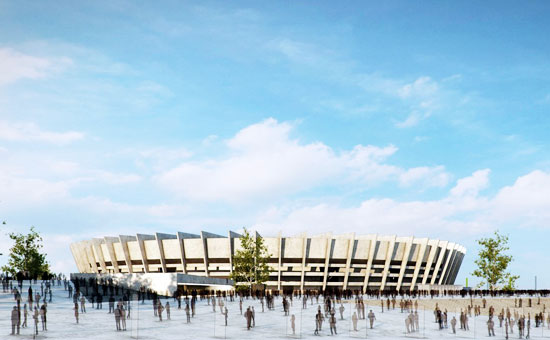Belo Horizonte(Estadio Mineirao)
Since the 18th century, during the days of the Inconfidência Mineira - an independence conspiracy against the domination of the Portuguese crown - the state of Minas Gerais gambled with the idea of instating a new capital to replace Ouro Preto. Once Brazil declared its independence (1822) and became a republic in 1889, the stage was set for a new capital to be chosen. Among several contestants, the small avillage of Curral del-Rei achieved the right to host the Cidade de Minas, officially inaugurated in 1897 and whose name was eventually changed in 1906 to Belo Horizonte (Portuguese for ‘beautiful horizon').

Engineer Aarao Reis, an admirer of Paris and Washington, D.C., was responsible for putting the urban planning for the new state capital together. What his project did not contemplate, though, was the fast-paced development through which Belo Horizonte would go after a period of stagnation in the first decades of the 20th century. Soon the city expanded beyond its original limits and new neighbourhoods had to be planned and developed - the most notorious of them the Pampulha, an area of wide avenues and many squares and parks designed in the 1940s by Brazil's premier architect Oscar Niemeyer.

Today Belo Horizonte - or Beagá, as the city is famously known, after the sound of initials BH in Portuguese - is the sixth-most populous city in Brazil with just over 2.4 million residents, while its metropolitan area comprising a total 34 cities ranks third in the country, behind Sao Paulo and Rio de Janeiro.

From the beauty of its green areas to the careful city-planning; from the wide array of cultural activities to the nature wonders of the Serra do Curral surrounding it, Belo Horizonte has several reasons for being constantly appointed as one of the Latin American metropolises that provides the best qualify of life.

Football
The number one question when someone meets a belo-horizontino is often the same: Atletico Mineiro or Cruzeiro? The city is in love with football and lives under a constant atmosphere of rivalry between two of the top contenders in Brazilian football: Clube Atlético Mineiro, the Galo (Rooster), and Cruzeiro Esporte Clube, also known as the Raposa (Fox). América Futebol Clube, the Coelho (Rabbit), is also a traditional state rival and has had its successful surges over the years.
Atlético Mineiro was the winner of the maiden edition of the Campeonato Brasileiro in 1971, and has been graced by the talents of Reinaldo, Toninho Cerezo and Eder, among others, while Cruzeiro's silverware collection goes from one Brasileiro in 2003 to four Copa do Brasil titles, two Copa Libertadores crowns (1976 and 1997). The Raposa were the first stage in the career of such big names as Tostao and Ronaldo.
The ultimate stage for the Atlético vs. Cruzeiro derbies and for the big matches held in the state of Minas Gerais is Governor Magalhaes Pinto stadium, famously known as the Mineirão; a 72,000-seater that has once housed over 100,000 fans and is one of the best and most charismatic football grounds in Brazil that has gone through modernisation work to turn it into a comfortable 58,000-seater.
Owner: Cruzeiro (MG)
Capacity: 62547
Country: Brazil
City: Belo Horizonte
Address: Av. Antonio Abrahao Caram, 1001 - Pampulha, Belo Horizonte
Value: About $287 million
Inauguration: 1965
Average temperature in June: 25°C

Profile:
One of the most historic venues in Brazilian football and called home by Atletico Mineiro and Cruzeiro, both former national champions, the 57,483 capacity Estadio Mineirao has undergone a complete overhaul prior to hosting six matches at the 2014 FIFA World Cup™ - including one semi-final.
The modernisation project included the lowering of the pitch surface and improving stadium accessibility, among other issues, with sustainability principles at the core of all work carried out. Exemplifying this approach is the facility to capture and store up to 6,270,000 litres of rainwater, which can then be reused.
Located in the Pampulha neighbourhood of Belo Horizonte and inaugurated on 5 December 1965, the stadium belongs to the Minas Gerais state government. Going by the official name of the Estadio Governador Magalhaes Pinto, in footballing circles it is almost universally known as the Mineirão.
Boasting an enthusiastic and vibrant atmosphere on matchdays, whether it be O Galo (Atletico Mineiro) or A Raposa (Cruzeiro) that are playing at home, the Mineirão has also proved a worthy setting for Brazilian national team matches – including A Seleção’s clashes with arch-rivals Argentina in FIFA World Cup qualifying encounters in 2004 and 2008.
What is more, the stadium has been regularly graced over the years by attacking legends such as Ronaldo, Tostao, Reinaldo and Dario.
Matches:
14/06/2014 13:00 Colombia vs. Greece
17/06/2014 13:00 Belgium vs. Algeria
21/06/2014 13:00 Argentina vs. Iran
24/06/2014 13:00 Costa Rica vs. England
28/06/2014 13:00 1A vs. 2B
08/07/2014 17:00 Semifinals W57 vs. W58
Local hero:
Tostao, a member of the 1970 World Cup winning team, scored 32 goals in 52 games for what is considered the greatest side there has been. He once scored 47 goals in one game in his schooldays. With 300 career goals to his name, injury forced his retirement at just 25.

Legends pay tribute to Gerrard & Lahm
International retirements follow Wo...
- Year
- Winner
- Runner-up
- Third place
